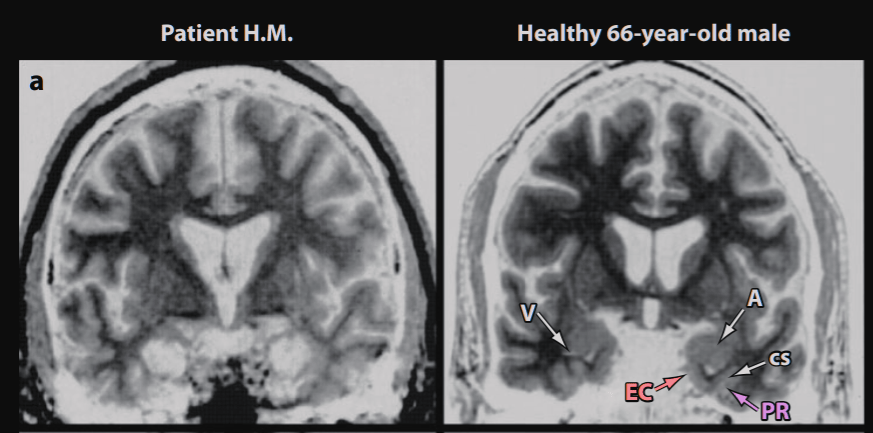Possibly one of the most famous cases in cognitive neuroscience was Patient H.M.. He experienced violent epileptic seizures as a young man, which were controlled by temporal lobe surgery. Large parts of the temporal lobe including the hippocampus were removed. The operation was successful: H.M. no longer suffered from epilepsy. Instead, he showed massive memory deficits (Squire, 2009). He suffered from both anterograde and retrograde amnesia. This meant he could no longer store new memories and had difficulties accessing old memories from before surgery (Squire & Wixted, 2011). Strikingly, his other cognitive and perceptual abilities remained unchanged and his IQ increased even (Eichenbaum, 2012). This selective destruction of memory led to the assumption that the hippocampus has a special role in memory functions.

Since other parts of the brain were also affected the drawn conclusions are not perfectly correct. Another patient – R.B. – who suffered from a very selective ischaemic infarction which destroyed the CA 1 layer of the hippocampus also experienced memory impairment. This layer plays a critical role as it is the direct connection of the hippocampus with the entorhinal cortex and the subiculum (Squire & Wixted, 2011).
In the following study of the hippocampus in relation to memory, links between spatial memory skills and the hippocampus were revealed. A famous study was conducted with London taxi drivers (Maguire et al., 2000). It was demonstrated that the posterior hippocampal region was enlarged in London taxi drivers compared to bus drivers and the size of the posterior hippocampus correlated with the amount of time the subjects had been working as a taxi driver. This means that people for whom their navigation skills were of particular importance had a significantly enlarged posterior hippocampus (Maguire et al., 2000). Rosenbaum et al., 2000 tested the spatial memory of patient K.C., who was severely amnesic with extensive bilateral hippocampal damage. While he could not draw a plan of his recent work place – demonstrating impairment in acquiring new spatial memories – he showed normal performance in allocentric spatial memory tests of his neighborhood and the world, indicating that the hippocampus is only necessary until information is stored elsewhere.
Regarding the areas that are relevant for encoding, storage and retrieval, the multiple trace theory (MTT) currently dominates.The MTT suggests an influence of long-term interactions between the hippocampal complex and neocortex to stabilize semantic memories within the neocortex (Nadel et al., 2000). This is in contrast to the standard consolidation theory (Squire 1992) stating constant involvement of the hippocampal complex in storage and retrieval of episodic memories. A critical distinction between episodic and semantic memory is important since only one of these brain regions becomes independent of the hippocampal complex in the course of consolidation. Nadel et al. were able to show the importance of the hippocampal complex for a functional episodic memory and spatial detail throughout the life of such memories, which verifies a fundamental part of MTT.